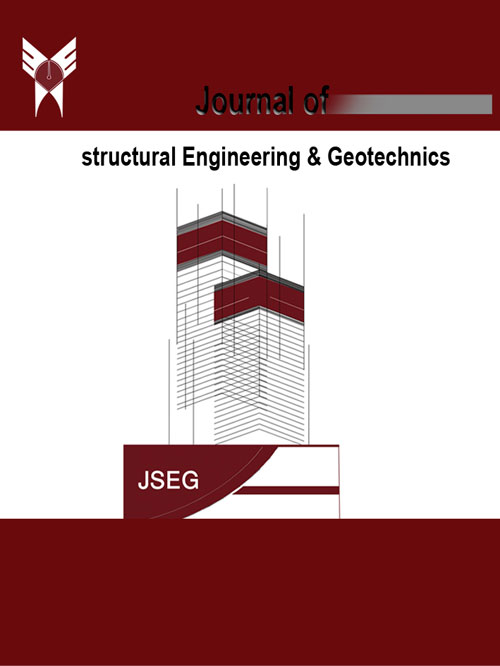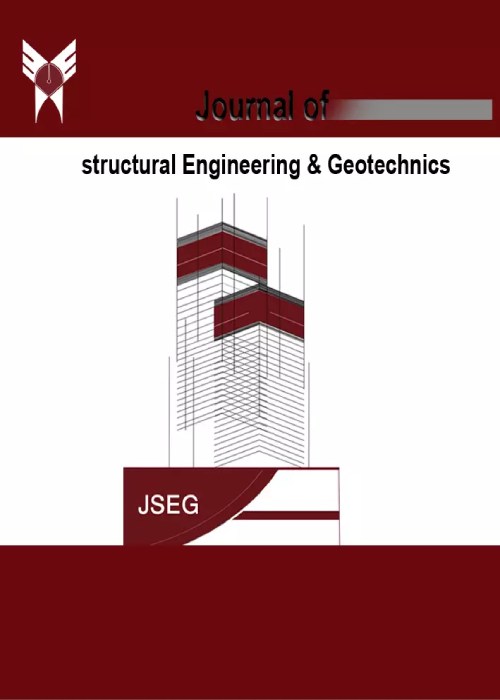فهرست مطالب

Journal of the Structural Engineering and Geotechnics
Volume:6 Issue: 1, Winter 2016
- تاریخ انتشار: 1394/11/28
- تعداد عناوین: 6
-
Pages 1-8In this article, we tried to emphasis in how the range of torsionally stiff and flexible single story buildings works. The designed base was according to provisions of the Canadian standard, 2005 NBCC. The behavior of nonlinear dynamic time history of eight building models subjected to seven horizontal bi-directional ground motions compatible with design spectra are investigated. These models cover a wide range of torsionally stiff to flexible buildings. Response parameters are element ductility demand and building story drift ratio. These criteria are appropriate indices for structural and nonstructural damages, respectively. This investigation shows that the linear static and dynamic analysis of building codes such as the 2005 NBCC and its framework are not generally adequate for structures with extremely low torsional stiffness. The provisions in mentioned codes and its framework are able to limit ductility demand, but they do not limit drift to the allowable level for extremely torsional structure.Keywords: Keywords: Ductility, Torsion, National Building Code of Canada (NBCC), Non, linear dynamic analysis, Story drift ratio, Performance level
-
Pages 9-13Assessing the behavior of composite structures which are subjected to impact loads is one of the important subjects in the field of mechanical sciences. Using thin-walled tubes which collapsed and absorbed the impact energy is a well-known method to prevent damages to the other parts of the structures. In this paper, deformations, crushing length, peak load, mean force and energy absorption capacity of thin-walled circular composite tubes are investigated both experimentally and numerically. In order to experimental study, three circular composite tubes were fabricated and subjected to quasi-static axial load. Also, a finite element model was constructed and analyzed under same conditions using FEM27 and LS-DYNA software packages. The results of simulations are in good agreement with the experimental data and show that the section geometry has considerable effect on the energy absorption. The circular composite tube has the most energy absorption capacity and the most average force among all investigated sections.Keywords: Absorbed energy, axial compression, circular composite tube, experimental setup, finite element method
-
Pages 15-22One of the methods for the improvement of soil against the tensile stresses is using the artificial supplements in soil such as metal belts or nets, polymer materials and natural fibers. Technically this method is called the reinforced of soil. When a pavement is located on soft soil, great deformations can occur as a result of the crossing of traffic load in superstructure layers of the body. This can finally lead to the increase in the cost of maintenance and traffic pause in transportation. The main purpose of this study is to explore the effect of geotextile layers place in various depths of the body of pavement layers located on soft soil. For this purpose, models with the identical geometry from the transection of road using Finite Element Method software, PLAXIS were analyzed in two dimensions in which the location and the number of geotextile layers were considered in various depths. In continue, these models have been under static and dynamic loadings due to vehicles and the settlement rate and the lateral deformation of pavement in section has been evaluated. The results show that in static loading, the maximum safety factor of stability is that of layers in which the geotextile exists in the partition between subgrade and embankment layers. Also, between dynamic loading and increasing number of geotextile layers favorable result is not achieved. Although more studies need to be carried out in this area.Keywords: Static Loading, Dynamic Loading, Pavement Design, Geotextile, Soil Improvement, Traffic
-
Pages 23-30Moment-resisting frames have extensive usage in earthquake-prone areas and high ability in energy dissipation.After the earthquake in Northridge 1994,Kobe 1995 fixed connections of steel structures have shown poor performance and generally they were caught brittle fracture of beam flange weld to the column.In order to remedy to avoid similar situations in future earthquakes,researchers introduced connection with reduced beam section in name of RBS(Reduced Beam Section),that stress concentration at the junction can be prevented by reducing the local section of beam in the vicinity column and location of plastic hinge transferred from connection to the distance from the column.
In this research, firstable the three special steel moment-resisting frames of three-dimension 5,10 and 15 story with seismic compressed sections as RBS was analyzed as time history by using SAP software at the near and far field earthquakes with and without considering the effect of vertical component,then a critical connections in each of the frames was modeled by ANSYS software and it was analyzed as dynamic under obtained loads from each record(in SAP).
The study results showed that the vertical component put negative effects on the performance of this type of connection in terms of concentration of stress, strain and ductility.It is necessary to say that the negative effect of the vertical component on the connections at near field earthquakes was comparatively more than at far field earthquakes.Keywords: Near field, Far field, Reduced beam section, Vertical component, RBS connection -
Pages 31-36Today analyzing seismicity hazard urban different areas is critical and inevitable due to develop and to expand cities in seismically active zones and naturally, the hazard because the earthquake is more in the bigger cities and the necessity to consider these hazards would be increased. Expanding the cities in Iran seismically active zones caused to be necessary to analyze earthquake hazard. Bouinzahra, Qazvin and Hamedan as cities in subject to earthquake hazard are perfect relevant instances. These important cities have been surrounded among active faults and its possible always to happen a big earthquake on it. For probabilistic risk analysis for different levels of software EZF RISK that a program is incredibly strong in this field has been used. This study analyzes the seismic hazard of earthquake for these 3 cities considering this truth by Probabilistic and Deterministic analyzing method. The results showed the relative level of earthquake hazard is high in these cities and its according to suggesting opinion of Iranian code of practice for seismic resistant design of buildings (2800).Keywords: Probabilistic analysis, Deterministic analysis, EZF RISK, ZMAP, Seismic Hazard of Bouinzahra, Qazvin, Hamedan zones
-
Pages 37-43Time-history analysis is defined as a kind of dynamic analysis increasingly used in design of structures and evaluation of existing ones. One of the important issues in the Time-history analysis is selecting earthquake records. In this case, seismic design provisions states that time histories shall have similar source mechanisms, geological and seismological features with region under study. Alborz is one of the highly seismic regions of Iran which records of large events are not sufficiently available. For this reason, the main objective of this research is to modeling strong motion records and comparing those with observed records. For modeling strong motion at a particular site three main elements: regional earthquake source, propagation path effects and local site conditions should consider. In this study stochastic finite fault approach for generation earthquake accelerographs was used. The use of a finite fault model is particularly important in improving the reliability of estimates for large-magnitude events at close distances. Finally after comparing the results, the generated records are found to be consistent with observed records in Alborz region.Keywords: Dynamic analysis, Alborz region, Accelerographs, Stochastic finite fault


